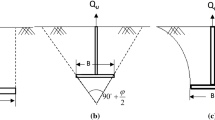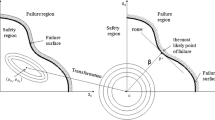Abstract
The design methods currently used for earth reinforcement are mostly based on deterministic properties of both the soil and the construction materials used. Nowadays, however, the general trend is designing at a specific degree of reliability. This is even more true where the raw data such as soil properties exhibit significant variation. Deterministic solutions, in this case, may not suffice. Therefore, this paper will attempt to use probabilistic formulations thereby modifying the existing design procedure of reinforced earth retaining walls to account for uncertainties and variabilities. Through a first order Taylor's series expansion about the mean, the mean and variance of the strip reinforcing components, namely width and length, are derived in terms of the variations in the soil properties. Design charts that enable estimation of both mean and variance are developed to avoid extensive partial differentiation involved in the computations. Using appropriate probability distributions along with the mean and variance, the final design outputs are determined for a selected failure probability by introducing what is refered to as 'risk index'. The results indicate that the risk index increases with an increase in the coefficient of variations and a decrease in failure probability. Furthermore, it is shown that in some cases, depending on the variabilities of the soil properties, the classical design technique produced a relatively high failure probability.
Similar content being viewed by others
References
Ang, A. H. and Tang, W. H. (1975). Probability Concepts in Engineering Planning and Design, Vol. II, John Wiley, New York.
Basma, A. A. (1991). Safety and reliability of anchored bulkhead walls, Structural Safety, 10(5), 283–295.
Basheer, I. A. and Najjar, Y. M. (1994) Reliability-based design of reinforced earth retaining walls, Transportation Research Record, 1526, 64–78.
Benjamin, J. R. and Cornell, C. A. (1970). Probability, Statistics, and Decision for Civil Engineers, McGraw-Hill, New York.
Bennett, R. M. (1987). Comments on the first order vs. second order reliability analysis of series structures. Structural Safety, 4(8), 241–242.
Berg, R. R., Bonapart, R., Andeson, R. P. and Chouery, V. E. (1986). Design construction of two tensor geogrid reinforced walls. Proc., Third Int'l Conf. on Geotextiles, Vienna, 401–406.
Bergado D. T., Teerawattanasuk C., Youwai S. and Voottipruex P. (2000). Finite element modeling of hexagonal wire reinforced embankment on soft clay. Can. Geotech. J./Rev. Can. Geotech. 37(6), 1209–1226.
Chen, Z. and Li, S. (1998). Evaluation of active earth pressure by the generalized method of slices. Can. Geotech. J./Rev. Can. Geotech. 35(4), 591–599.
Das, B. M. (1995).Principles of Foundation Engineering. 4th Ed., PWS Publishing Co., Boston, U.S.A.
Greco, V. R. (2001). Active earth thrust on cantilever walls with short heel. Can. Geotech. J./ Rev. Can. Geotech. 38(2), 401–409.
Gnanapragasam N. (2000). Active earth pressure in cohesive soils with an inclined ground surface. Can. Geotech. J./Rev. Can. Geotech. 37(1), 171–177.
Harr, M. E. (1977). Mechanics of Particulate Media: A Probabilistic Approach. McGraw-Hill, N.Y., U.S.A.
Jones, C. J. F. P. (1984). Design and Construction Methods. Proc. of Symp. on Polymer Grid Reinforcement. Institute of Engineers, London, Paper No. 6.1.
Koerner, R. B. (1990). Design with Geosynthetics. 2nd Ed., Prentice-Hall, N.J.
Krahn, J. and Fredlund, D. G. (1983). Variability in the engineering properties of natural soil deposits. Proc. of 4th Intl. Conf. on Appl. of Prob. and Stat. in Soil and Struc. Engrg., Italy, 1017–1029.
Laba, J. T. and Kennedy, J. B. (1986). Reinforced earth retaining walls analysis and design. Can. Geotech. J. 23(3), 317–326.
NCHRP, Report No. 209, (1987). Reinforcement of Earth Slopes and Embankments. Transportation Research Board, Washington, D.C.
Romstad, K. M., Al-Yassin, Z., Herrmann, L. R. and Shen, C. K. (1978). Stability analysis of earth retaining structures. Proc. ASCE Symposium on Earth Reinforcement, Pittsburgh, Penn., 685–713.
Rowe, R. Kerry and Ho, S. K. (1998). Horizontal deformation in reinforced soil walls. Can. Geotech. J./Rev. Can. Geotech. 35(2), 312–327.
Schlosser, F. and Long, N. T. (1974). Recent results in French research on reinforced earth. ASCE J. of Const. Div. 100(CO3), 223–237.
Thamm, B. R., Krieger, B. and Krieger, J. (1990). Full-scale test on geotextile-reinforced retaining structures. Proc. of 4th Intl. Conf. on Geotextiles, Geomembranes and Related Products, The Hague, 1, 3–8.
Author information
Authors and Affiliations
Rights and permissions
About this article
Cite this article
Basma, A.A., Barakat, S.A. & Omar, M.T. Reliability based risk index for the design of reinforced earth structures. Geotechnical and Geological Engineering 21, 225–242 (2003). https://doi.org/10.1023/A:1024932408001
Issue Date:
DOI: https://doi.org/10.1023/A:1024932408001




